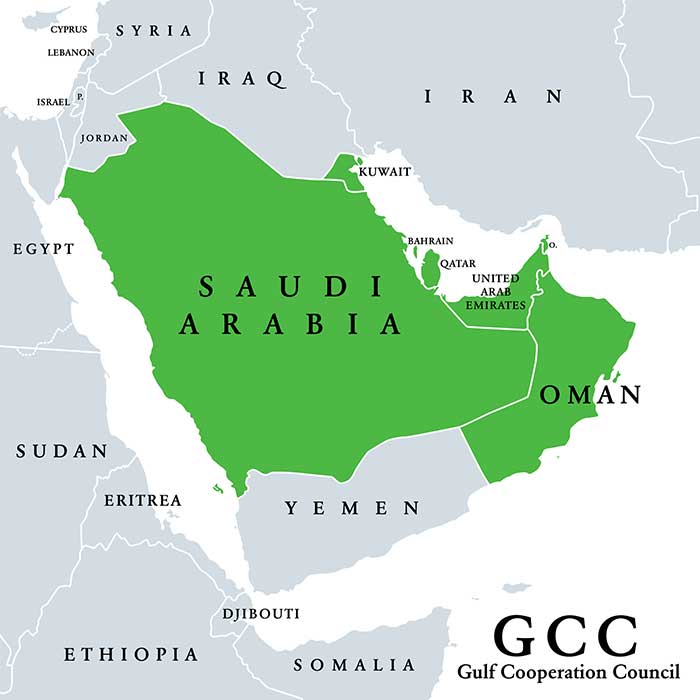China’s Multilateral Trade With Saudi Arabia, 2023/24 Status and Prospects
By Farzad Ramezani Bonesh
Trade relations between China and the Arab countries go ack at least 1,500 years, when Chinese goods came to the Arabian Peninsula and Arab goods were transported to East Asia.
China and Saudi Arabia established diplomatic relations in July 1990, with bilateral relations developing comprehensively over the past few decades. In June 2008, China and Saudi Arabia established a “Strategic friendly relationship.”
Bilateral trade with the signing of a memorandum of understanding in November 1988; bilateral trips such as the visit of the then president of China to Saudi Arabia in October 1999, the signing of the strategic oil agreement, and so on have helped China surpass the United States in bilateral trade with Saudi Arabia. In January 2016, Riyadh and Beijing also announced the establishment of a comprehensive strategic partnership. Chinese President Xi Jinping visited Saudi Arabia in December 2022, and the two countries signed a comprehensive strategic partnership agreement. The two countries are also negotiating a Free Trade Agreement via the Gulf Cooperation Council. The latest updates on this can be viewed here.
Areas of cooperation
Growing geopolitical interests
Many in Riyadh see China as an emerging superpower and a key partner in a multipolar world, so building strategic relationships has become vital. Apart from the relative presence of Saudi Arabia in the Shanghai Cooperation Organization, Riyadh is preparing to join the BRICS grouping.
In recent years, the two countries have developed political relations and close high-level exchanges. The importance of a “comprehensive strategic partnership”, focusing on common points and opportunities, Saudi Arabia’s support for China in political issues and Riyadh’s efforts to maintain stability in the international energy market, non-interference in each other’s internal affairs, especially in Xinjiang and Hong Kong, and the desire of political elites have led to commercial development.
Crude oil and energy
China is the world’s largest buyer of crude oil and has gradually become the largest customer of Saudi crude oil. It is also the largest trading partner for the Saudi chemical industry. Roughly half of all bilateral trade in 2021 was crude oil imports. According to Chinese sources, in the first 10 months of 2022, oil imports from Saudi Arabia reached 1.77 million barrels per day.
Saudi Aramco also has annual supply contracts with Chinese refineries such as Sinopec, CNPC, CNOOC, Sinochem, and Norinco. Aramco’s decision in early 2022 to build a US$10 billion refinery and petrochemical complex in northeastern China is considered the most significant investment in China.
Also, Saudi investment in Huajin Chemical Industries Group Corporation, Panjin Xincheng, investments in Zhejiang Petrochemical Company, stock purchases, and others are examples of cooperation in China’s energy sector.
Also, Beijing’s efforts in collaboration or joint investment with Aramco in YASREF, the 400,000 barrels per day refinery on the coast of the Red Sea, the memorandum between Saudi Aramco and Shandong Energy, China’s presence in Saudi Aramco’s oil pipelines or the purchase of 49% of the shares of Aramco Gas Pipelines Company, are other examples of the two side’s cooperation in the Saudi energy sector.
The growing use of natural synergy in solar energy is also important. Saudi Arabia and China have also signed an agreement on carbon and hydrogen absorption.
In December 2022, they signed a series of agreements, focused on areas such as green energy and electricity generation. In the past years, Saudi Arabia and China have signed nine memorandums of understanding to finance, invest and build clean and renewable energy projects, including the construction of a 2.6 GW solar power plant in Saudi Arabia and BRI member countries, such as joint investment in a 1.5 GW (GW) gas power plant in Uzbekistan.
Saudi initiatives and the Belt & Road Initiative
Beijing’s efforts to advance the BRI were welcomed by Saudi Arabia, and in 2016, an intergovernmental memorandum of understanding was signed on the joint construction of the Belt & Road Initiative.
From Riyadh’s point of view, China’s support for Saudi Arabia’s “Vision 2030” and “Green Middle East” and a series of development initiatives are important. Therefore, mutual and regional cooperation between China’s BRI and Saudi Arabia’s Vision 2030 has been strengthened by signing an executive plan for joint construction in December 2022. These programs naturally complement each other as in 2022, Saudi Arabia was the largest recipient of Chinese investments in the BRI with US$5.5 billion.
Finance and Investment
China’s investments in Saudi Arabia have shown steady growth. Saudi Arabia has been one of the largest recipients of Chinese contracts and investments in West Asia, and the range of cooperation has expanded from energy trade to investment in infrastructure, communications, advanced technology, industry, finance, transportation, renewable energy and others, while the expansion of cooperation in the fields of e-commerce and digital economy is also evident.
Chinese President Xi Jinping’s visit to Riyadh in December 2022 will further strengthen economic, investment, and trade relations with 34 investment contracts for services, transportation, logistics, medical industries, housing, worth more than US$50 billion.
Recently, in a meeting in Riyadh, China, and Saudi Arabia announced the investment of US10 billion and the signing of 30 contracts in mining, technology, renewable energy, agriculture, real estate, mining, tourism, and health.
Also, the Saudi financial market has grown, with Riyadh becoming one of the financial centers in the Middle East. Sino-Saudi financial cooperation, such as the first Chinese bank in Saudi Arabia and the collaboration of Chinese-Saudi financial institutions and banks, has created more opportunities.
A previous memorandum of understanding between Saudi Arabia’s Sumou and China-based Enovate Motors to establish an electric vehicle plant in Saudi Arabia is another dimension of the cooperation between the two sides. This new investment will allow the Chinese luxury electric car company – Human Horizons to build a new car manufacturing facility in Saudi Arabia.
Other areas of cooperation
Another dimension, is the China-GCC free trade agreement. Beijing wants to “accelerate” the talks and reach an FTA. Also, efforts such as holding large business conferences between Arabs and China have also helped to strengthen relations. China is helping Riyadh to launch uranium exploration and nuclear industry. Military relations between Saudi Arabia and China, especially in the field of arms sales, the signing of US$30 billion in defense contracts, joint exercises, and anti-terrorism cooperation, have also helped to develop relations in the field of trade and economy.
Trade volumes
Saudi Arabia has become China’s largest trading partner in the Middle East and North Africa (MENA) and China’s largest global supplier of crude oil.
China is the largest trading partner of Arab countries, with Saudi Arabia accounting for 25% of the total volume of trade between China and Arab countries, reaching US$106 billion in 2022 and showing a 30% increase compared to 2021.
China’s import volume was US$78.05 billion, which increased by 37% compared to 2021. Saudi imports from China reached US$28 billion.
Riyadh has become the first US$100 billion trading partner for Beijing in the Middle East. China mainly exports textiles, mechanical and electrical products, steel products, clothing, etc., and mainly imports crude oil, petrochemical products, plastics, and organic chemicals.

Prospects of future trade between China and Saudi Arabia
There are obstacles such as market access concerning the proposed China-GCC FTA. However, the two countries are in a good position to expand cooperation, and Beijing’s growing economic interests have demanded that its investments in Saudi Arabia not be threatened.
China’s oil demand will increase to 13 million barrels of oil imports per day by 2035. China will continue to be the top market for Saudi crude oil, with most of this oil being supplied to China from other Middle Eastern markets as well as Saudi Arabia.
Saudi Arabia’s Public Investment Fund (PIF) is also preparing for a major investment in China. Chinese companies are set to benefit from the awarding of huge Saudi infrastructure contracts.
Saudi’s 2030 vision, with its strategic goals and the strategy of the US$500 billion NEOM initiative, its Red Sea project, and the Middle East green initiative are important opportunities for the prospect of short-term and long-term bilateral cooperation between China and Saudi Arabia. There are also new opportunities for cooperation in tourism, telecommunications, renewable energy, smart cities, artificial intelligence life management systems, and technology.
In several surveys conducted amongst the nine Middle East and North Africa countries, China is seen as more popular than the United States and as a key future ally. Saudi Arabia has also expressed its willingness to accept oil payments from Beijing in Chinese currency. With relations expended to continue to develop with an eventual GCC trade agreement, and continuing Saudi involvement in the BRICS and Shanghai Cooperation Organisation, the future for this bilateral dynamic appears assured.
Dezan Shira & Associates assist foreign investors into Asia and provide market intelligence, legal, tax and corporate advisory services. We have 13 offices in China, one in Hong Kong and a partner firm in Riyadh. For assistance, please contact asia@dezshira.com. Our ‘Doing Business in China’ guide can be seen below.
Related Reading
- China, Saudi Arabia Announce Massive Strategic Partnership Energy Agreement
 An Introduction to Doing Business in China 2023
An Introduction to Doing Business in China 2023
About Us
Middle East Briefing is one of five regional publications under the Asia Briefing brand. It is supported by Dezan Shira & Associates, a pan-Asia, multi-disciplinary professional services firm that assists foreign investors throughout Asia, including through offices in Dubai (UAE), China, India, Vietnam, Singapore, Indonesia, Italy, Germany, and USA. We also have partner firms in Malaysia, Bangladesh, the Philippines, Thailand, and Australia.
For support with establishing a business in the Middle East, or for assistance in analyzing and entering markets elsewhere in Asia, please contact us at dubai@dezshira.com or visit us at www.dezshira.com. To subscribe for content products from the Middle East Briefing, please click here.
- Previous Article UAE Plans To Double GDP To Over US$800 Billion By 2030
- Next Article China’s Total Middle East and Africa Trade Up To US$1.63 Trillion





